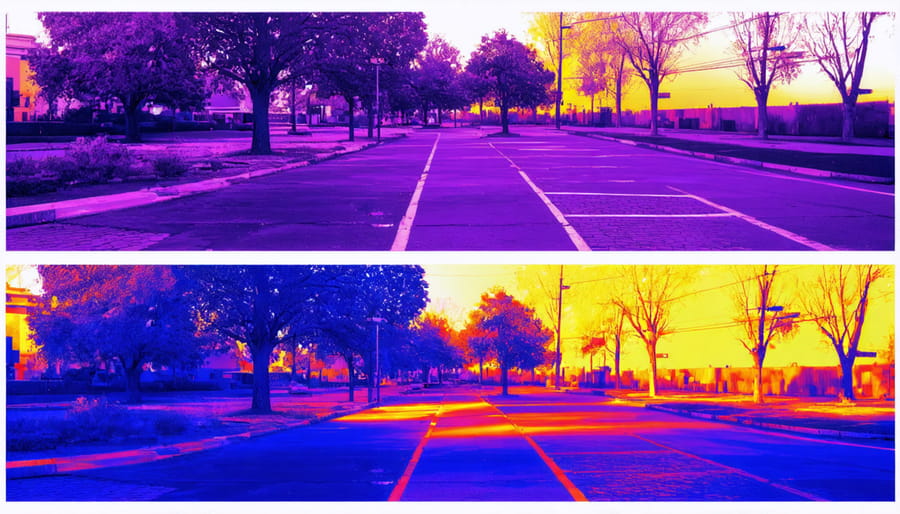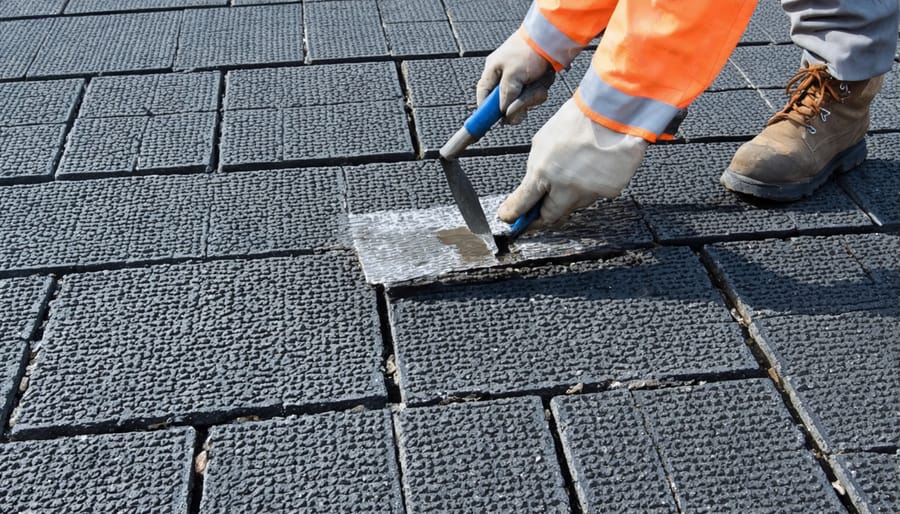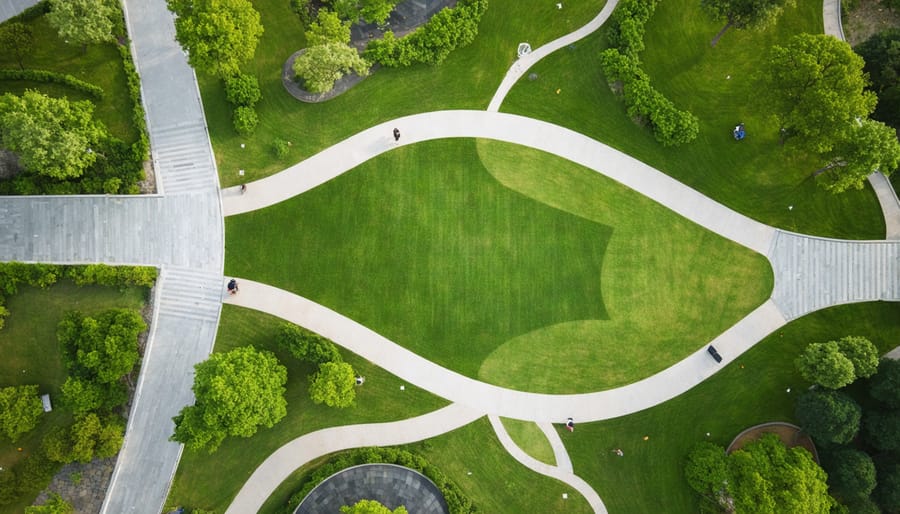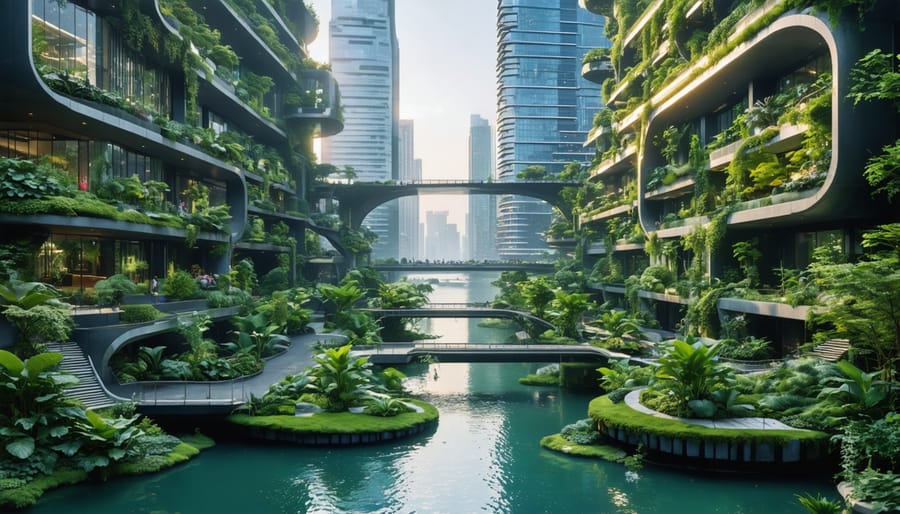Climate-responsive landscaping transforms urban developments into resilient ecosystems that actively combat environmental challenges while reducing operational costs by up to 30%. By integrating climate adaptation strategies with smart plant selection and innovative water management systems, construction professionals can create sustainable landscapes that adapt to extreme weather patterns and support local biodiversity.
Recent data from the American Society of Landscape Architects demonstrates that strategically designed landscapes reduce building energy consumption by 25%, manage stormwater runoff by up to 65%, and significantly decrease the urban heat island effect. These performance metrics underscore the critical role of climate-responsive landscaping in modern construction projects, particularly as metropolitan areas face increasing environmental pressures.
Professional landscape architects and construction managers must now approach site development through the lens of climate resilience, incorporating advanced soil engineering, indigenous plant species, and automated irrigation systems that respond to real-time weather data. This integrated approach not only ensures project longevity but also delivers measurable returns on investment through reduced maintenance costs and enhanced property values.
The Science Behind Climate-Responsive Landscapes
Urban Heat Island Mitigation
Strategic urban heat island mitigation through landscaping offers a powerful solution to combat rising urban temperatures. By implementing carefully planned vegetation and surface treatments, construction professionals can significantly reduce ambient temperatures by 2-8°C in developed areas.
Green infrastructure elements, including strategic tree placement and vegetative cover, provide essential shade and enhance evapotranspiration. Large-canopy trees strategically positioned along southern and western exposures can reduce surface temperatures by up to 45°C, while simultaneously decreasing cooling energy demands by 20-30% in adjacent buildings.
The selection of appropriate surface materials plays a crucial role in temperature regulation. High-albedo pavements and cool roofing materials with solar reflectance indices (SRI) above 29 can decrease surface temperatures by up to 30°C compared to conventional materials. Integration of permeable pavements further contributes to cooling through evaporative processes.
Vertical gardens and green walls provide additional cooling benefits, reducing building surface temperatures by 15-20°C while creating microhabitats that support urban biodiversity. When combined with proper irrigation systems and native plant selection, these solutions offer sustainable, long-term temperature management without excessive maintenance requirements.
For maximum effectiveness, professionals should consider implementing these strategies at both site and neighborhood scales, creating interconnected networks of green infrastructure that amplify cooling effects across urban areas.

Water Management Solutions
Effective water management is crucial in climate-responsive landscaping, combining sustainable drainage systems (SuDS) with innovative conservation techniques. These solutions address both water scarcity and excess rainfall challenges while supporting ecosystem resilience.
Modern SuDS implementations incorporate permeable pavements, bioswales, and rain gardens that facilitate natural water infiltration and filtration. These systems effectively reduce runoff by up to 85% while replenishing groundwater reserves. Rain gardens, particularly when designed with native species, can process up to 30% more water than traditional drainage systems while supporting local biodiversity.
Water conservation strategies include smart irrigation systems that utilize soil moisture sensors and weather data to optimize water usage. These systems typically achieve 30-50% water savings compared to conventional methods. Rainwater harvesting systems, ranging from simple rain barrels to sophisticated underground cisterns, can supply up to 85% of landscape irrigation needs in many climates.
Strategic plant selection plays a vital role in water management. Xeriscaping principles, when properly implemented, can reduce irrigation requirements by 50-75%. This approach combines drought-resistant plants with efficient hydrozoning – grouping vegetation by water needs to maximize irrigation efficiency.
Recent innovations include greywater recycling systems integrated with landscape design, providing sustainable irrigation solutions while reducing pressure on municipal water supplies. These systems can recycle up to 70% of household water for landscape use, offering significant environmental and economic benefits.
Key Elements of Climate-Responsive Landscape Design
Native Plant Selection
Native plant selection forms the cornerstone of successful climate-responsive landscaping, offering superior adaptation to local conditions while minimizing resource consumption. When selecting vegetation, professionals should prioritize species indigenous to the project’s geographic region, considering their natural resilience to local temperature extremes, precipitation patterns, and soil conditions.
Key selection criteria include drought tolerance, heat resistance, and root system characteristics. Plants with deep root systems contribute to soil stability and enhanced stormwater management, while those with moderate water requirements reduce irrigation demands. Consider mature plant size, growth rate, and seasonal variations to ensure long-term sustainability and reduced maintenance needs.
For optimal performance, analyze the microclimate conditions of different areas within the site. South-facing slopes may require more drought-resistant species, while low-lying areas might accommodate plants with higher moisture requirements. Group plants with similar water needs together to facilitate efficient irrigation zones.
Native plants also support local biodiversity by providing habitat and food sources for indigenous wildlife. This ecological integration enhances project sustainability while contributing to broader environmental resilience. When specifying plant materials, consult local botanical gardens and agricultural extension services for region-specific recommendations and performance data.
Document plant selections in detailed specifications, including scientific names, expected mature sizes, and specific maintenance requirements. This ensures proper installation and establishes clear guidelines for long-term landscape management.
Permeable Surface Solutions
Implementing effective permeable surface solutions represents a crucial component of sustainable construction practices, particularly in urban environments where water management is critical. Modern permeable materials, including pervious concrete, porous asphalt, and interlocking pavers, offer superior water infiltration capabilities while maintaining structural integrity.
Recent advancements in permeable surface technology have yielded innovative solutions such as reinforced grass systems and resin-bound aggregates, which can handle significant traffic loads while allowing up to 850mm/hr of water penetration. These systems typically comprise multiple layers: a surface course, bedding layer, sub-base, and geotextile membrane, each contributing to effective water management and filtration.
Performance data from major urban installations demonstrates that properly designed permeable surfaces can reduce stormwater runoff by 70-90% compared to traditional impervious surfaces. This reduction significantly decreases the burden on municipal drainage systems and helps replenish groundwater reserves.
Key considerations for implementation include:
– Soil permeability assessment
– Traffic load requirements
– Local climate conditions
– Maintenance protocols
– Sub-grade preparation specifications
Engineers should factor in long-term maintenance requirements, as regular cleaning and inspection are essential to maintain optimal performance. Advanced monitoring systems can now track infiltration rates and alert maintenance teams when intervention is needed, ensuring sustained effectiveness throughout the installation’s lifecycle.
Green Infrastructure Integration
Green infrastructure integration serves as a cornerstone of climate-responsive landscaping, offering natural solutions to urban environmental challenges. Bioswales, strategically positioned along roadways and in parking lots, effectively manage stormwater runoff while filtering pollutants through specialized vegetation and engineered soils. These systems typically reduce peak flow volumes by 60-70% and capture up to 80% of suspended solids.
Rain gardens complement bioswales by creating localized depression areas that collect and filter rainfall through layers of engineered soil media. These installations require careful consideration of soil composition, typically incorporating 60% sand, 20% topsoil, and 20% organic matter to optimize water infiltration and pollutant removal. Professional implementation should ensure a minimum depth of 18-24 inches for optimal performance.
Green corridors connect these individual elements, creating continuous vegetation networks that enhance biodiversity and improve urban climate resilience. These corridors require strategic planning to maintain connectivity and should incorporate native species adapted to local climate conditions. Successful implementation often involves a three-tiered vegetation structure: groundcover, understory, and canopy layers.
Industry best practices recommend integrating these elements early in the design phase, with particular attention to site topography and existing drainage patterns. Construction professionals should conduct thorough soil analysis and ensure proper grading to maximize system effectiveness. Regular maintenance schedules, including quarterly inspections and annual soil testing, are essential for long-term performance.

Implementation Strategies for Construction Projects
Site Assessment and Planning
Effective site assessment forms the foundation of successful climate-responsive landscaping. Begin with a comprehensive analysis of the site’s microclimate, including solar exposure patterns, prevailing wind directions, and seasonal temperature variations. Document existing vegetation, soil conditions, and drainage patterns through detailed site surveys and soil testing.
Consider the topographical features that influence local climate conditions, such as slopes, valleys, and existing structures. These elements affect wind patterns, water flow, and solar gain – crucial factors in climate-responsive design. Analyze surrounding buildings and infrastructure to understand their impact on shade patterns and wind tunnels.
Create detailed maps highlighting sun and shade patterns throughout different seasons. This information guides plant selection and placement, helping optimize natural cooling and heating effects. Conduct a thorough water assessment, including annual rainfall patterns, surface runoff, and potential for water harvesting.
Assessment should also include evaluation of existing hardscape materials and their thermal properties. Document heat island effects and identify opportunities for mitigation through strategic vegetation placement and material selection.
Develop a site preparation plan that addresses soil improvement, drainage modification, and necessary grade changes. Consider phasing construction to minimize environmental impact and maintain existing beneficial features. Include contingency plans for extreme weather events during the construction phase.
The final planning phase should integrate collected data into a cohesive design strategy that maximizes climate resilience while meeting project objectives. This approach ensures long-term sustainability and reduces maintenance requirements.
Construction Considerations
Implementing climate-responsive landscaping requires careful consideration of site conditions and proper construction methodologies. The installation process begins with comprehensive soil analysis and topographical surveys to determine optimal placement of vegetation and hardscape elements. Integration of climate-ready construction materials is essential for ensuring long-term resilience and sustainability.
Critical factors include proper drainage systems installation, with particular attention to bioswales and retention basins that manage stormwater runoff. Soil preparation must incorporate appropriate amendments to support plant health while maintaining proper infiltration rates. Construction teams should implement erosion control measures during the installation phase to prevent soil loss and protect water quality.
Infrastructure considerations encompass irrigation system design, incorporating smart controllers and moisture sensors for water conservation. Hardscape elements require careful grading to direct water flow and minimize heat island effects. Project managers must coordinate construction sequencing to protect existing vegetation and soil structure during installation.
Equipment selection should prioritize low-impact machinery to minimize soil compaction. Timing of construction activities should account for seasonal weather patterns and optimal planting windows. Quality control measures must verify proper installation depths for plants, accurate grading for drainage, and appropriate soil compaction levels for various landscape features.

Maintenance Requirements
Maintaining climate-responsive landscapes requires a strategic approach that balances environmental benefits with operational efficiency. Regular monitoring of soil moisture levels and plant health is essential, particularly during extreme weather events. Professional landscape managers should implement seasonal maintenance schedules that adapt to changing climate patterns.
Key maintenance activities include selective pruning to maintain optimal shade coverage and wind protection, while ensuring proper air circulation. Irrigation systems require quarterly inspections and calibration to maximize water efficiency and prevent waste. Smart irrigation controllers should be reprogrammed seasonally to account for rainfall patterns and evapotranspiration rates.
Soil management is critical for long-term sustainability. Annual soil testing helps maintain proper pH levels and nutrient content, while periodic amendments with organic matter enhance water retention capabilities. Native plant species typically require less intensive maintenance but still need periodic assessment for disease and pest resistance.
Hardscape elements demand regular inspection for structural integrity, particularly after severe weather events. Permeable surfaces require annual cleaning to prevent clogging and maintain optimal water infiltration rates. Green infrastructure components, such as bioswales and rain gardens, need bi-annual maintenance to ensure proper functionality.
Documentation of maintenance activities and system performance helps optimize future interventions and validate the landscape’s climate resilience strategies. This data-driven approach enables continuous improvement of maintenance protocols while demonstrating ROI to stakeholders.

Case Studies: Success Stories in Urban Resilience
The transformation of urban landscapes through climate-responsive design has yielded remarkable results across several major cities. These innovative resilience projects demonstrate the tangible benefits of integrating climate adaptation strategies into urban development.
Copenhagen’s Cloudburst Management Plan stands as a pioneering example of large-scale climate adaptation. Following severe flooding in 2011, the city implemented a network of green corridors and water-retention parks that can temporarily store excess rainwater during extreme weather events. The Sankt Kjelds Quarter transformation has reduced flood risk by 30% while creating vibrant public spaces that serve multiple community functions.
Singapore’s Gardens by the Bay exemplifies vertical green infrastructure integration. The 101-hectare development features sophisticated temperature regulation systems, including photovoltaic cells powering climate-controlled conservatories and vertical gardens that reduce ambient temperatures by up to 3°C. The project has achieved a 30% reduction in energy consumption compared to conventional cooling systems.
Portland’s Green Street Program demonstrates successful distributed stormwater management. By implementing over 2,000 green street facilities, the city has managed to capture and filter 80% of stormwater runoff, significantly reducing the burden on traditional infrastructure. These bioswales and rain gardens have also increased urban biodiversity by 40% and reduced heat island effects in treated areas by up to 2°C.
Rotterdam’s Water Square Benthemplein showcases innovative multi-functional design. This urban plaza serves as both a community recreation space and a water retention facility during heavy rainfall. The project can store up to 1.7 million liters of water, significantly reducing flood risk while providing valuable public space. During dry weather, the sunken areas serve as sports courts and performance venues.
These success stories share common elements: comprehensive stakeholder engagement, integrated design approaches, and clear performance metrics. The projects demonstrate that climate-responsive landscaping can deliver multiple benefits beyond climate resilience, including enhanced biodiversity, improved public health outcomes, and strengthened community cohesion. Monitoring data from these implementations provides valuable insights for future projects, showing that initial investment costs are typically offset by reduced maintenance expenses and avoided damage costs within 7-10 years.
Climate-responsive landscaping represents a crucial evolution in sustainable urban development, combining environmental stewardship with practical construction solutions. As our industry continues to face increasing climate challenges, the implementation of these adaptive strategies has become not just beneficial, but essential for long-term project success.
The evidence clearly demonstrates that well-executed climate-responsive landscapes can reduce energy consumption by up to 30%, manage stormwater more effectively, and significantly improve urban resilience. These benefits extend beyond individual projects to contribute to broader environmental goals while delivering tangible cost savings for stakeholders.
Looking ahead, the integration of smart technologies and advanced materials will further enhance the effectiveness of climate-responsive landscaping. Emerging trends point toward the increased use of IoT sensors for irrigation management, climate-adaptive plant species selection, and innovative permeable materials that optimize water management.
For construction professionals, the key to success lies in early integration of these principles during the planning phase, comprehensive site analysis, and careful consideration of local climate patterns. The future of construction inevitably leads toward more sustainable, adaptive approaches, making expertise in climate-responsive landscaping an invaluable asset.
As we move forward, continued research, technological advancement, and industry collaboration will be crucial in developing even more effective solutions for climate challenges. The investment in climate-responsive landscaping today will yield significant returns in environmental protection, resource efficiency, and project sustainability for years to come.

